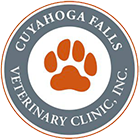Some questions and thoughts we’ve heard over the phone and in our examination rooms…
Why is veterinary care so expensive?
The cost of veterinary care is ultimately determined by each pet’s owner. The definition of “expensive” varies greatly from person to person, and the idea of what constitutes “acceptable care” is unique to each pet owner. All we can do at the Cuyahoga Falls Veterinary Clinic is make our clients aware of the choices available for their pet’s current situation and then guide them through the options. The final decision is left to the pet owner.
It should also be said that the cost of veterinary care over the past 20 to 30 years has not increased at nearly the rate of comparable human health care. For instance, the cost of routine bloodwork for cats and dogs, a CBC and a blood chemistry profile, is around $130. On the human side, someone is paying anywhere from $400 to $700 for the same information… either you are or your insurance provider (and remember, they’re collecting monthly premiums from you and your employer on your behalf). Want an ultrasound or radiographs or surgery? The difference between veterinary cost and human cost is even greater for these services. The truth is, veterinary health care is a tremendous value considering the degree of services received for the dollars spent.

Each day we go the extra mile for our clients, but we also expect pet owners to be prepared for the associated expenses of animal ownership and to understand that veterinarians should be compensated for their professional services and related expenses.
Why can’t you advise/diagnose/prescribe treatment for my pet over the phone?
It is both unethical and illegal (Ohio Revised Code 4741.04) to prescribe for an animal that has not been physically examined by a veterinarian. This fits under the concept of a Veterinary-Client-Patient Relationship (VCPR). Additionally, no veterinarian can make a diagnosis based upon the descriptions of a pet owner. Often, the symptoms observed are consistent with any number of conditions, and these conditions may require very different treatment plans. Under most circumstances, a physical examination and other diagnostic tests are needed to determine the underlying problem and to determine the best treatment plan.
My pet needs to be seen, but I just lost my job/don’t get paid until Friday/etc.
Most pet owners have a regular veterinarian who will work out payment options. Problems arise, though, when pet owners do not seek regular veterinary care and do not establish a relationship with a veterinary clinic, but then demand and seek services in an emergency situation without any guarantee of payment. If you choose to not form a relationship with a veterinary practice, you should consider how you will manage your financial situation in the event of an emergency.
At the Cuyahoga Falls Veterinary Clinic, our payment options include Visa, MasterCard, Discover and CareCredit (in addition to cash and check). These are options that can allow our clients to spread out their costs over time, especially in the case of CareCredit, which offers interest-free, longer-term payment plans.
Is pet insurance a good idea?
We’ve written a blog post on just that topic!
If you can’t fix my pet’s problem, can I get a refund?
The fees associated with the care of your pet cover the examination, diagnostic tests, treatments and medications. Because animals are living things, some problems can be long-term and involve complex underlying causes. Sometimes these causes even change over time. While we desire to cure all ills, sometimes this is simply not possible. You are paying for an honest attempt to diagnose and treat your pet’s condition and there is no implied guarantee of outcome.
We understand that questions arise, particularly when cost is involved. This is why we have put a number of options and payment methods in place so you can work toward the best quality-of-life for your pet-friend.

